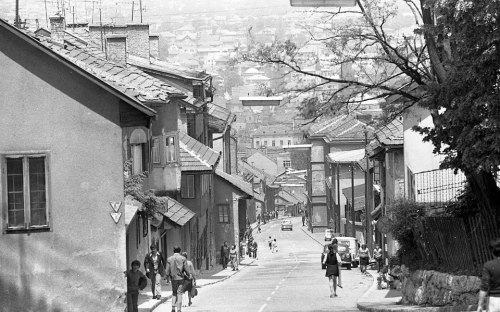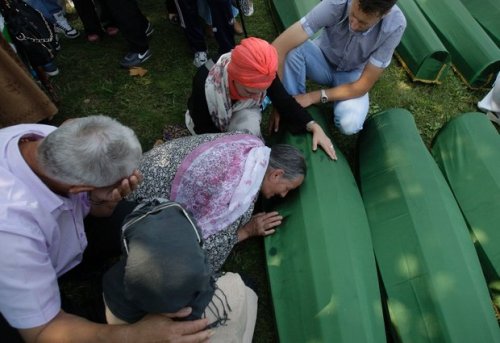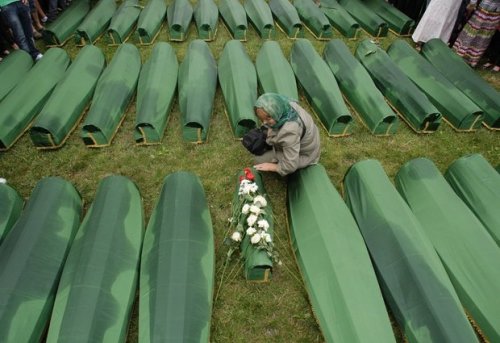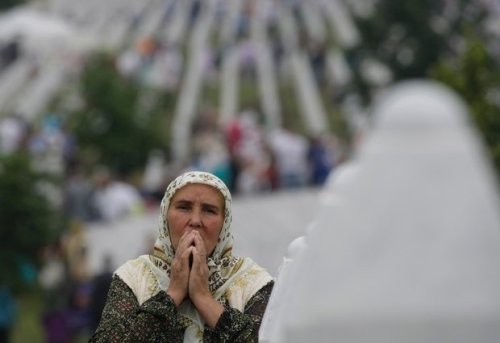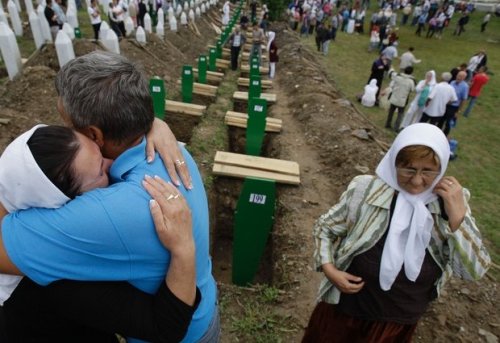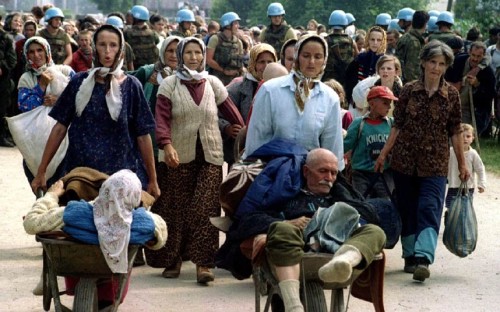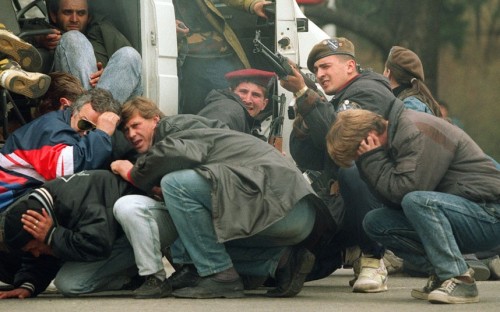#bihpovijest
Case Black or the Battle of the Sutjeska was a joint attack by the Axis taking place from 15 May to 16 June 1943, which aimed to destroy the main Yugoslav Partisan force, near the Sutjeska river in south-eastern Bosnia. The failure of the offensive marked a turning point for Yugoslavia during World War II.
The operation immediately followed Case White which had failed in accomplishing the same objectives: to eliminate the central Partisan formations and capture their commander, Marshal Josip Broz Tito.
The successful Partisan breakout helped their reputation as a viable fighting force with the local populace. The battle marked a turning point toward Partisan control of Yugoslavia, and became an integral part of the Yugoslav post-war mythology, celebrating the self-sacrifice, extreme suffering and moral firmness of the partisans.
Post link
Why is there no caption on photos like these? This is a photo from Mostar during the Bosnian war.
Post link
fakjumather-deactivated20150125:
Vahida Maglajlić – courageous heroine in the fight against Fascism
(Vahida Maglajlić was born in Banja Luka on 17 April 1907 as the oldest of ten children of the president of a Muslim sharia court. After graduating from a girls’ school, she wanted to continue her education, but her father insisted that she become a housewife. Through her brothers she came into contact with Marxism and the workers’ movement. She was one of the first women to participate actively in the movement and to become a member of the organisation “Women’s Movement”. She joined the Communist Party of Yugoslavia on 1 May 1941. After the occupation of the kingdom of Yugoslavia and the formation of the independent state of Croatia, to which Bosnia & Herzegovina also belonged, she took an active part in the preparations for the organisation of a ceasefire. She joined the partisans in 1942 and became politically active. She supported the formation of the Anti-Fascist Front. Vahida died on 1 April 1943 in a village near Bosanski Novi after a surprise attack on the local brigade by the Germans. For a long time the medical school in Banja Luka bore her name, and it has only recently changed its name to Banja Luka Medical School. Two books have been written about this extraordinary woman: “Zapisi” in 2004, and “Moja porodica” in 2007.)
There have always been outstanding women who have influenced the course of history. They have fought for their rights in a male world, against restrictions of all kinds and traditional values imposed by society, and against unequal treatment and discrimination. Their achievements have changed the way we think.
Such personalities also existed in Bosnia & Herzegovina during the Second World War. No doubt because of the patriarchal society women were unfortunately not entrusted with major tasks. Tradition and conservative values meant that they were required to focus on their families rather than their own personal advancement. Vahida Maglajlić was one woman who showed that this did not need to be the case.
Fearless angel
In spite of her origins in a wealthy, educated and well-off family in Banja Luka, Vahida Maglajlić soon realised that she could not be satisfied with the role of a housewife and that this was not her mission in life. While still young she joined “Women’s Movement”, an organisation for successful women, where she was very active, while not neglecting her role as the oldest sister in her own family. Her vital energy and strength were inexhaustible. She selflessly communicated her talent for the good and beautiful to her siblings and friends. At home she was the central focus and driving force within the family.
Selfless commitment
Her energy and flexibility came to the fore particularly in 1941 when Banja Luka and the country as a whole were preparing to rise up against the occupants, and many people required help and support. Banja Luka was a supply centre for partisans. The family house was transformed into a store and headquarters for the preparation of food and collection of clothing, ammunition and arms for the partisans. Vahida soon attracted the attention of the Fascists. She was arrested, tortured and interrogated, but she refused to capitulate and engineered her own escape, about which a number of version abound.
Posthumous people’s hero
Vahida Maglajlić fell into the hands of the Fascists and was buried on 1 April 1943 with twenty-seven other partisans in the village of Velika Rujiška. She was transferred shortly afterwards to the partisans’ cemetery in Banja Luka, where her grave can be visited today. She is the only Muslim woman in ex-Yugoslavia to have been declared a people’s hero.
Role model for Palestinian women
Her unbroken will in fighting Fascism was renowned far beyond the borders of ex Yugoslavia. Inspired by her courage and self-determination a Palestinian by the name of El Helou Mohamed wrote a leaflet about Vahida and put her face on the cover as an example to women in the Palestinian Liberation Organisation. He succeeded in this regard and Vahida was admired by freedom fighters throughout Palestine.
(viawieninternational.at)
Fuck yeah Bosnian women.
Post link
Mostar, Bosnia, September 1992.
A Bosnian soldier plays the piano in the destroyed music school in town.
Photo by Teun Voeten.
Post link
SREBRENICA, Bosnia-Herzegovina (AP) — Tens of thousands have gathered in Bosnia to rebury 409 newly identified victims of the 1995 Srebrenica massacre on the 18th anniversary of the worst slaughter on European soil since the Nazi era.
Among the victims are 43 teenage boys and a baby that was born during the ordeal. They are being laid to rest at a special cemetery near Srebrenica where victims are buried as their remains are gradually found in mass graves. As of Thursday, there were 6,066; a further 2,306 are still missing.
In July 1995, Serb forces overran the U.N.-protected Muslim town in eastern Bosnia and executed more than 8,000 men and boys within days.U.N. troops on the ground did nothing to stop them.
_________________________________________________________
11.7.1995 »> NEVER FORGIVE AND NEVER FORGET!!!
Shame on you UN - you were suppose to help and not let innocent men and boys get killed. They trusted you!!!
Post link
- July 1995: A group of Bosnian Muslims, refugees from Srebrenica, walk to be transported from the eastern Bosnian village of Potocari to Moslem-held Kladanj near Olovo.
- The siege of the Bosnian capital Sarajevo was between May 1992 and November 1995. About 10,000 people died under terrifying sniper and artillery fire.
- July 1995: Refugees from the overrun U.N. safe haven enclave of Srebrenica looking through the razor-wire at newly arriving refugees in a UN base 12 kms south of Tuzla.
- March 1993; Muslim refugees ride in a truck in a UN convoy as they flee the Serb-besieged Bosnian enclave of Srebrenica for Tuzla.
- March 1996: Bosnian Serb refugees lead a cart with their belongings past the destroyed Mosque in the eastern Bosnian town of Srebrenica.
Post link












